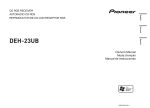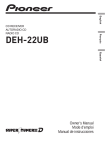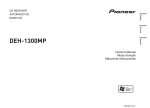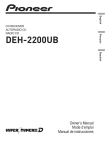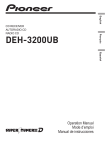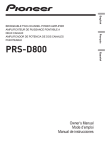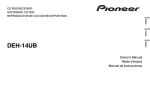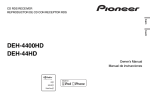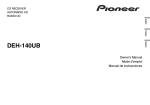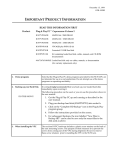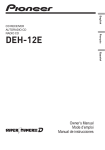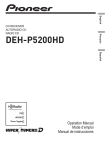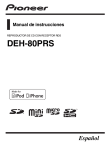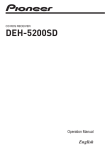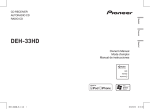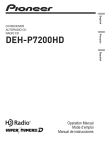Download Pioneer DXT-2266UB User's Manual
Transcript
DXT-2266UB Owner’s Manual Manual de instrucciones Español PAQUETE DE AUDIO PARA AUTOMÓVIL COMPLETO RADIO CD CON CUATRO ALTAVOCES DE DOS VÍAS 6-1/2” English COMPLETE CAR AUDIO PACKAGE CD RECEIVER WITH FOUR 6-1/2" 2WAY SPEAKERS Contents Thank you for purchasing this PIONEER product. To ensure proper use, please read through this manual before using this product. It is especially important that you read and observe WARNINGs and CAUTIONs in this manual. Please keep the manual in a safe and accessible place for future reference. Before You Start Information to User 3 For Canadian model 3 The Safety of Your Ears is in Your Hands 3 About this unit 3 After-sales service for Pioneer products 4 In case of trouble 4 Visit our website 4 Operating this unit Head unit 5 Display indication 5 Basic Operations 5 Menu operations identical for function settings/audio adjustments/initial settings/ lists 6 Tuner 6 CD/CD-R/CD-RW and USB storage devices 7 Audio Adjustments 8 Initial Settings 9 Using an AUX source 9 Displaying the clock 9 Connections Connection diagram 11 Installation DIN front/rear mount 12 Securing the front panel 13 Speaker installation 13 Additional Information Troubleshooting 16 Error messages 16 Handling guideline 17 Compressed audio compatibility (disc, USB) 18 Sequence of audio files 19 Copyright and trademark 19 2 En Specifications 20 Presection Before You Start Information to User Alteration or modifications carried out without appropriate authorization may invalidate the user’s right to operate the equipment. For Canadian model This Class B digital apparatus complies with Canadian ICES-003. The Safety of Your Ears is in Your Hands Get the most out of your equipment by playing it at a safe level—a level that lets the sound come through clearly without annoying blaring or distortion and, most importantly, without affecting your sensitive hearing. Sound can be deceiving. Over time, your hearing “comfort level” adapts to higher volumes of sound, so what sounds “normal” can actually be loud and harmful to your hearing. Guard against this by setting your equipment at a safe level BEFORE your hearing adapts. ! Once you have established a comfortable sound level, set the dial and leave it there. BE SURE TO OBSERVE THE FOLLOWING GUIDELINES: ! Do not turn up the volume so high that you can’t hear what’s around you. ! Use caution or temporarily discontinue use in potentially hazardous situations. ! Do not use headphones while operating a motorized vehicle; the use of headphones may create a traffic hazard and is illegal in many areas. English This device complies with part 15 of the FCC Rules. Operation is subject to the following two conditions: (1) This device may not cause harmful interference, and (2) this device must accept any interference received, including interference that may cause undesired operation. About this unit The tuner frequencies on this unit are allocated for use in North America. Use in other areas may result in poor reception. WARNING Handling the cord on this product or cords associated with accessories sold with the product may expose you to chemicals listed on proposition 65 known to the State of California and other governmental entities to cause cancer and birth defect or other reproductive harm. Wash hands after handling. CAUTION: USE OF CONTROL OR ADJUSTMENT OR PERFORMANCE OF PROCEDURES OTHER THAN THOSE SPECIFIED HEREIN MAY RESULT IN HAZARDOUS RADIATION EXPOSURE. CAUTION: THE USE OF OPTICAL INSTRUMENTS WITH THIS PRODUCT WILL INCREASE EYE HAZARD. ESTABLISH A SAFE LEVEL: ! Set your volume control at a low setting. ! Slowly increase the sound until you can hear it comfortably and clearly, without distortion. En 3 Presection Before You Start CAUTION ! Do not allow this unit to come into contact with liquids. Electrical shock could result. Also, damage to this unit, smoke, and overheating could result from contact with liquids. ! Always keep the volume low enough to hear outside sounds. ! Avoid exposure to moisture. ! If the battery is disconnected or discharged, any preset memory will be erased. CAUTION 1 Do not touch the speaker flexible wire 1. 2 Do not change the direction of the speaker terminal assembly 2. 3 Make sure lead and speaker terminals do not contact metal. 4 When making connections, refer also to the instruction manual of the car stereo used. U.S.A. Pioneer Electronics (USA) Inc. CUSTOMER SUPPORT DIVISION P.O. Box 1760 Long Beach, CA 90801-1760 800-421-1404 CANADA Pioneer Electronics of Canada, Inc. CUSTOMER SATISFACTION DEPARTMENT 300 Allstate Parkway Markham, Ontario L3R 0P2 1-877-283-5901 905-479-4411 For warranty information please see the Limited Warranty sheet included with this unit. In case of trouble Should this unit fail to operate properly, please contact your dealer or nearest authorized PIONEER Service Station. 2 1 Important (Serial number) The serial number is located on the bottom of this unit. For your own security and convenience, be sure to record this number on the enclosed warranty card. After-sales service for Pioneer products Please contact the dealer or distributor from where you purchased this unit for after-sales service (including warranty conditions) or any other information. In case the necessary information is not available, please contact the companies listed below: Please do not ship your unit to the companies at the addresses listed below for repair without advance contact. 4 En Visit our website http://www.pioneerelectronics.com in Canada http://www.pioneerelectronics.ca ! Learn about product updates (such as firmware updates) for your product. ! Register your product to receive notices about product updates and to safeguard purchase details in our files in the event of loss or theft. ! Access owner's manuals, spare parts information, service information, and much more. Section Operating this unit 01 Indicator Part Part 1 DISP/ 8 AUX input jack (3.5 mm stereo jack) 2 SRC/OFF 9 USB port 3 MULTI-CONTROL (M.C.) a 4 Disc loading slot b 1 to 6 5 h (eject) c a/b/c/d 6 CLOCK d BAND/ESC 7 Detach button /SCRL 3 Main display section 4 (song) 5 (list) Tuner: band and frequency Built-in CD player and USB: elapsed playback time and text information The track (song) name is displayed. A playable audio file has been selected while operating the list. (folder) The list function is operated. 7 d A lower tier of folder or menu exists. 8 LOC The local seek tuning is on. 9 LOUD (loudness) The loudness is on. a 5 (stereo) The selected frequency is being broadcasted in stereo. b (repeat) c (random) CAUTION Use an optional Pioneer USB cable (CD-U50E) to connect the USB audio player/USB memory as any device connected directly to the unit will protrude out from the unit and may be dangerous. Do not use unauthorized products. ! ! An upper tier of folder or menu exists. c 6 State d English Head unit (sound retriever) Track or folder repeat is on. Random play is on. The sound retriever function is on. Basic Operations Display indication Important Indicator State 1 (disc) The disc (album) name is displayed. 2 (artist) The disc (track) artist name is displayed. ! Handle gently when removing or attaching the front panel. ! Avoid subjecting the front panel to excessive shock. ! Keep the front panel out of direct sunlight and high temperatures. ! To avoid damage to the device or vehicle interior, remove any cables and devices attached to the front panel before detaching it. En 5 Section 01 Operating this unit Removing the front panel to protect your unit from theft 1 Press the detach button to release the front panel. 2 Grab the front panel and remove. ! Always keep the detached front panel in a protection device such as a protection case. Re-attaching the front panel 1 Slide the front panel to the left until it clicks. Front panel and the head unit are connected on the left side. Make sure that the front panel has been properly connected to the head unit. Menu operations identical for function settings/audio adjustments/initial settings/lists Returning to the previous display Returning to the previous list (the folder one level higher) 1 Press DISP/ /SCRL. Returning to the main menu Returning to the top tier of list 1 Press and hold DISP/ /SCRL. Returning to the ordinary display Canceling the initial setting menu 1 Press BAND/ESC. Returning to the ordinary display from the list 1 Press BAND/ESC or . 2 Press the right side of the front panel until it is firmly seated. If you can’t attach the front panel to the head unit successfully, try again. However, forcing the front panel into place may result in damage. Turning the unit on 1 Press SRC/OFF to turn the unit on. Turning the unit off 1 Press SRC/OFF and hold until the unit turns off. Selecting a source 1 Press SRC/OFF to cycle between: TUNER (tuner)—CD (built-in CD player)—USB (USB)—AUX (AUX) Adjusting the volume 1 Turn M.C. to adjust volume. Note When this unit’s blue/white lead is connected to the vehicle’s auto-antenna relay control terminal, the vehicle’s antenna extends when this unit’s source is turned on. To retract the antenna, turn the source off. Tuner Basic Operations Selecting a band 1 Press BAND/ESC until the desired band (F1, F2, F3 for FM or AM) is displayed. Manual tuning (step by step) 1 Press c or d. Seeking 1 Press and hold c or d, and then release. You can cancel seek tuning by briefly pressing c or d. While pressing and holding c or d, you can skip stations. Seek tuning starts as soon as you release c or d. Storing and recalling stations for each band You can easily store up to six stations for each band as presets. % When you find a station that you want to store in memory, press one of the preset tuning buttons (1 to 6) and hold until the preset number stops flashing. Stored radio station frequency can be recalled by pressing the preset tuning button. 6 En Section Operating this unit Function settings 1 Press M.C. to display the main menu. 2 Turn M.C. to change the menu option and press to select FUNCTION. 3 Turn M.C. to select the function. After selecting, perform the following procedures to set the function. BSM (best stations memory) BSM (best stations memory) automatically stores the six strongest stations in the order of their signal strength. 1 Press M.C. to turn BSM on. To cancel, press M.C. again. LOCAL (local seek tuning) Local seek tuning lets you tune in to only those radio stations with sufficiently strong signals for good reception. 1 Press M.C. to display the setting mode. 2 Turn M.C. to select the desired setting. FM: OFF—LEVEL 1—LEVEL 2—LEVEL 3—LEVEL 4 AM: OFF—LEVEL 1—LEVEL 2 The highest level setting allows reception of only the strongest stations, while lower levels allow the reception of weaker stations. 3 Press M.C. to confirm the selection. Stopping playback of files on a USB storage device 1 You may disconnect the USB storage device at anytime. English # You can also recall stored radio stations by pressing a or b during the frequency display. 01 Selecting a folder 1 Press a or b. Selecting a track 1 Press c or d. Fast forwarding or reversing 1 Press and hold c or d. Returning to root folder 1 Press and hold BAND/ESC. Switching between compressed audio and CD-DA 1 Press BAND/ESC. Notes ! When playing compressed audio, there is no sound during fast forward or reverse. ! Disconnect USB storage devices from the unit when not in use. Displaying text information Selecting the desired text information 1 Press DISP/ /SCRL. CD TEXT discs: Play time—disc title—disc artist name—track title—track artist name WMA/MP3: Play time—folder name—file name —track title—artist name—album title—comment—bit rate—folder and track numbers WAV: Play time—folder name—file name—sampling frequency—folder and track numbers Scrolling the text information to the left 1 Press and hold DISP/ /SCRL. CD/CD-R/CD-RW and USB storage devices Basic Operations Playing a CD/CD-R/CD-RW 1 Insert the disc into the disc loading slot with the label side up. Ejecting a CD/CD-R/CD-RW 1 Press h. Playing songs on a USB storage device 1 Open the USB connector cover and plug in the USB storage device using a USB cable. Note Depending on the version of iTunes used to write MP3 files to a disc or media file types, incompatible text stored within an audio file may be displayed incorrectly. Selecting and playing files/ tracks from the name list 1 Press to switch to the file/track name list mode. En 7 Section Operating this unit 01 2 Use M.C. to select the desired file name (or folder name). Changing the file or folder name 1 Turn M.C. Playing 1 When a file or track is selected, press M.C. Viewing a list of the files (or folders) in the selected folder 1 When a folder is selected, press M.C. Playing a song in the selected folder 1 When a folder is selected, press and hold M.C. REPEAT (repeat play) 1 Press M.C. to display the setting mode. 2 Turn M.C. to select a repeat play range. For details, refer to Selecting a repeat play range on this page. 3 Press M.C. to confirm the selection. RANDOM (random play) 1 Press M.C. to turn random play on or off. PAUSE (pause) 1 Press M.C. to pause or resume. S.RTRV (sound retriever) Advanced operations using special buttons Selecting a repeat play range to cycle between the following: 1 Press 6/ CD/CD-R/CD-RW ! DISC – Repeat all tracks ! TRACK – Repeat the current track ! FOLDER – Repeat the current folder USB audio player/USB memory ! TRACK – Repeat the current file ! FOLDER – Repeat the current folder ! ALL – Repeat all files Audio Adjustments Playing tracks in random order 1 Press 5/ to turn random play on or off. Tracks in a selected repeat range are played in random order. 1 Pausing playback 1 Press 2/PAUSE to pause or resume. 3 Turn M.C. to select the audio function. After selecting, perform the following procedures to set the audio function. Enhancing compressed audio and restoring rich sound (sound retriever) 1 Press 1/S.Rtrv to cycle between: OFF (off)—1—2 1 is effective for low compression rates, and 2 is effective for high compression rates. Press M.C. to display the main menu. 2 Turn M.C. to change the menu option and press to select AUDIO. FAD/BAL (fader/balance adjustment) 1 Press M.C. to display the setting mode. 2 Press M.C. to cycle between fader (front/rear) and balance (left/right). 3 Turn M.C. to adjust speaker balance. Function settings EQUALIZER (equalizer recall) 1 1 Press M.C. to display the setting mode. 2 Turn M.C. to select the equalizer. DYNAMIC—VOCAL—NATURAL—CUSTOM— FLAT—POWERFUL 3 Press M.C. to confirm the selection. Press M.C. to display the main menu. 2 Turn M.C. to change the menu option and press to select FUNCTION. 3 Turn M.C. to select the function. After selecting, perform the following procedures to set the function. 8 Automatically enhances compressed audio and restores rich sound. 1 Press M.C. to display the setting mode. 2 Turn M.C. to select the desired setting. For details, refer to Enhancing compressed audio and restoring rich sound (sound retriever) on this page. 3 Press M.C. to confirm the selection. En TONE CTRL (equalizer adjustment) Section Operating this unit Adjusted equalizer curve settings are stored in CUSTOM. 1 Press M.C. to display the setting mode. 2 Press M.C. to select BASS (bass)/MID (mid)/TREBLE (treble). 3 Turn M.C. to adjust the level. Adjustment range: +6 to -6 LOUDNESS (loudness) Loudness compensates for deficiencies in the lowand high-frequency ranges at low volume. 1 Press M.C. to display the setting mode. 2 Turn M.C. to select the desired setting. OFF (off)—LOW(low)—HIGH (high) 3 Press M.C. to confirm the selection. Activate this setting when using an auxiliary device connected to this unit. 1 Press M.C. to turn AUX on or off. English ! 01 USB (plug and play) This setting allows you to switch your source to USB automatically. 1 Press M.C. to turn the plug and play on or off. ON – When USB storage device is connected, the source is automatically switched to USB. If you disconnect your USB storage device, this unit’s source is turned off. OFF – When USB storage device is connected, the source is not switched to USB automatically. Please change the source to USB manually. SLA (source level adjustment) SLA (Source Level Adjustment) lets you adjust the volume level of each source to prevent radical changes in volume when switching between sources. ! When selecting FM as the source, you cannot switch to SLA. ! Settings are based on the FM volume level, which remains unchanged. ! The AM volume level can also be adjusted with this function. 1 Press M.C. to display the setting mode. 2 Turn M.C. to adjust the source volume. Adjustment range: +4 to –4 3 Press M.C. to confirm the selection. Using an AUX source 1 Insert the stereo mini plug into the AUX input jack. 2 Press SRC/OFF to select AUX as the source. # AUX cannot be selected unless the auxiliary setting is turned on. For more details, refer to AUX (auxiliary input) on this page. Displaying the clock Initial Settings % Press CLOCK to turn the clock display on or off. 1 Press SRC/OFF and hold until the unit turns off. # The clock display disappears temporarily when you perform other operations, but the clock display appears again after 25 seconds. 2 Press M.C. and hold until CLOCK SET appears in the display. 3 Turn M.C. to select the initial setting. After selecting, perform the following procedures to set the initial setting. CLOCK SET (setting the clock) 1 Press M.C. to display the setting mode. 2 Press M.C. to select the segment of the clock display you wish to set. Hour—Minute 3 Turn M.C. to adjust the clock. AUX (auxiliary input) En 9 Section 02 Connections WARNING ! Use speakers over 50 W (output value) and between 4 W to 8 W (impedance value). Do not use 1 W to 3 W speakers for this unit. ! The black cable is ground. When installing this unit or power amp (sold separately), make sure to connect the ground wire first. Ensure that the ground wire is properly connected to metal parts of the car’s body. The ground wire of the power amp and the one of this unit or any other device must be connected to the car separately with different screws. If the screw for the ground wire loosens or falls out, it could result in fire, generation of smoke or malfunction. Ground wire Other devices (Another electronic device in the car) POWER AMP Metal parts of car’s body Important F O N OF ! When installing this unit in a vehicle without an ACC (accessory) position on the ignition switch, failure to connect the red cable to the terminal that detects operation of the ignition key may result in battery drain. STAR T ACC position No ACC position ! Use this unit with a 12-volt battery and negative grounding only. Failure to do so may result in a fire or malfunction. ! To prevent a short-circuit, overheating or malfunction, be sure to follow the directions below. — Disconnect the negative terminal of the battery before installation. — Secure the wiring with cable clamps or adhesive tape. Wrap adhesive tape around 10 En wiring that comes into contact with metal parts to protect the wiring. — Place all cables away from moving parts, such as the gear shift and seat rails. — Place all cables away from hot places, such as near the heater outlet. — Do not connect the yellow cable to the battery by passing it through the hole to the engine compartment. — Cover any disconnected cable connectors with insulating tape. — Do not shorten any cables. — Never cut the insulation of the power cable of this unit in order to share the power with other devices. The current capacity of the cable is limited. — Use a fuse of the rating prescribed. — Never wire the negative speaker cable directly to ground. — Never band together negative cables of multiple speakers. ! When this unit is on, control signals are sent through the blue/white cable. Connect this cable to the system remote control of an external power amp or the vehicle’s auto-antenna relay control terminal (max. 300 mA 12 V DC). If the vehicle is equipped with a glass antenna, connect it to the antenna booster power supply terminal. ! Never connect the blue/white cable to the power terminal of an external power amp. Also, never connect it to the power terminal of the auto antenna. Doing so may result in battery drain or a malfunction. Section Connections 02 English Connection diagram Power amp (sold separately) This product Connect with RCA cables (sold separately) Antenna jack Fuse (10 A) Rear output Yellow Connect to the constant 12 V supply terminal. System remote control Blue/white Connect to system control terminal of the power amp or auto-antenna relay control terminal (max. 300 mA 12 V DC). Red Connect to terminal controlled by ignition switch (12 V DC). With a 2 speaker system, do not connect anything to the speaker leads that are not connected to speakers. Black (chassis ground) Connect to a clean, paint-free metal location. Front speaker White White/black Gray Gray/black Left Rear speaker Rear speaker Front speaker Right Green Green/black Violet Violet/black Rear speaker Rear speaker Perform these connections when using the optional amplifier. En 11 Section 03 Installation Important ! Check all connections and systems before final installation. ! Do not use unauthorized parts as this may cause malfunctions. ! Consult your dealer if installation requires drilling of holes or other modifications to the vehicle. ! Do not install this unit where: — it may interfere with operation of the vehicle. — it may cause injury to a passenger as a result of a sudden stop. ! The semiconductor laser will be damaged if it overheats. Install this unit away from hot places such as near the heater outlet. ! Optimum performance is obtained when the unit is installed at an angle of less than 60°. 2 Secure the mounting sleeve by using a screwdriver to bend the metal tabs (90°) into place. 1 2 1 Dashboard 2 Mounting sleeve 3 Install the unit as illustrated. Use commercially available parts when installing. 1 2 60° 4 DIN front/rear mount This unit can be properly installed using either front-mount or rear-mount installation. DIN Front-mount 1 Insert the mounting sleeve into the dashboard. For installation in shallow spaces, use the supplied mounting sleeve. If there is enough space, use the mounting sleeve that came with the vehicle. 12 En 3 5 1 Nut 2 Firewall or metal support 3 Metal strap 4 Screw 5 Screw (M4 × 8) # Make sure that the unit is installed securely in place. An unstable installation may cause skipping or other malfunctions. Section Installation 03 3 English DIN Rear-mount Pull the unit out of the dashboard. 1 Determine the appropriate position where the holes on the bracket and the side of the unit match. 2 Tighten two screws on each side. 3 1 Securing the front panel The front panel can be secured with the supplied screw. 2 1 1 Mounting sleeve 2 Mounting bracket 3 Dashboard or console Use either truss (5 mm × 8 mm) or flush surface (5 mm × 9 mm) screws, depending on the bracket screw holes. 1 Screw Speaker installation 1 1 Removing the unit 1 Remove the trim ring. 1 1 Trim ring ! Releasing the front panel allows easier access to the trim ring. ! When reattaching the trim ring, point the side with the groove down. 2 3 Front 1 45° 2 4.3 mm holes (3/16 in. Dia.) 3 f 142 mm (5-5/8 in. Dia.) 2 Insert the supplied extraction keys into both sides of the unit until they click into place. En 13 Section Installation 03 1 2 3 45 6 7 Side 1 2 3 4 5 6 7 13 mm (1/2 in.) 42 mm (1-5/8 in.) f 171 mm (6-3/4 in. Dia.) f 75 mm (3 in. Dia.) f 128 mm (5 in. Dia.) f 158 mm (6-1/4 in. Dia.) 30 mm (1-3/16 in.) 2 Make holes as illustrated. (If needed, remove the door upholstery.) 1 1 Determine the location of the speaker as illustrated. 2 1 f 4.5 (3/16 Dia.) 2 f 128 mm (5 in. Dia.) 3 14 En Remove the mesh from the grille. Section Installation English 4 03 Install the speakers as illustrated. 1 2 3 1 2 1 2 1 2 1 Speed nut 2 Tapping-screws (4 mm × 18 mm) 3 Cable (gray or white) En 15 Appendix Additional Information Troubleshooting Message Symptom Cause The display automatically returns to the ordinary display. You did not per- Perform operation form any opera- again. tion within about 30 seconds. Action Select the repeat The repeat play Depending on play range again. range changes the repeat play unexpectedly. range, the selected range may change when selecting another folder or track, or when fast forwarding/reversing. Subfolders cannot be played when FOLDER (folder repeat) is selected. Select another repeat play range. NO XXXX ap- There is no text information empears when a display is chan- bedded. ged (NO TITLE, for example). Switch the display or play another track/file. A subfolder is not played back. The unit is malfunctioning. There is interference. You are using a device, such as a cellular phone, that transmits electromagnetic waves near the unit. Move electrical devices that may be causing the interference away from the unit. Error messages Message Cause ERROR-11, 12, The disc is dirty. 17, 30 The disc is scratched. The inserted disc Replace the disc. is blank ERROR-22, 23 Unsupported CD Replace the disc. format FRMT READ Sometimes there is a delay between the start of playback and when you start to hear any sound. NO AUDIO The inserted disc Replace the disc. does not contain any playable files. SKIPPED The inserted disc Replace the disc. contains DRM protected WMA files. PROTECT Replace the disc. All the files on the inserted disc are embedded with DRM. 16 En Wait until the message disappears and you hear sound. USB storage device Message Cause Action NO DEVICE When plug and play is off, no USB storage device is connected. ! Turn the plug and play on. ! Connect a compatible USB storage device. FRMT READ Sometimes there is a delay between the start of playback and when you start to hear any sound. Wait until the message disappears and you hear sound. NO AUDIO There are no songs. Transfer the audio files to the USB storage device and connect. The connected USB storage device has security enabled Follow the USB storage device instructions to disable the security. Action Clean the disc. Replace the disc. Action ERROR-15 When you contact your dealer or your nearest Pioneer Service Center, be sure to note the error message. Built-in CD Player Cause ERROR-10, 11, There is an elec- Turn the ignition 12, 15, 17, 30, trical or mechan- switch OFF and back ON, or switch ical error. A0 to a different source, then back to the CD player. Appendix Additional Information Cause Action Message Cause Action The connected USB storage device contains WMA files embedded with Windows Mediaä DRM 9/10 Play an audio file not embedded with Windows Media DRM 9/10. ERROR-23 USB storage device is not formatted with FAT16 or FAT32 USB storage device should be formatted with FAT16 or FAT32. PROTECT All the files in the USB storage device are embedded with Windows Media DRM 9/10 Transfer audio files not embedded with Windows Media DRM 9/10 to the USB storage device and connect. N/A USB The connected USB storage device is not supported by this unit. Connect a USB Mass Storage Class compliant device. CHECK USB The USB connector or USB cable has shortcircuited. Check that the USB connector or USB cable is not caught in something or damaged. The connected USB storage device consumes more than 500 mA (maximum allowable current). Disconnect the USB storage device and do not use it. Turn the ignition switch to OFF, then to ACC or ON and then connect only compliant USB storage devices. ERROR-18 ERROR-19 Not compatible USB device Communication failed. English Message SKIPPED Handling guideline Discs and player Use only discs featuring either of following two logos. Use 12-cm disc. Do not use 8-cm disc or an adapter for 8-cm disc. Use only conventional, fully circular discs. Do not use shaped discs. Do not insert anything other than a CD into the CD loading slot. Disconnect your device and replace it with a compatible USB storage device. Do not use cracked, chipped, warped, or otherwise damaged discs as they may damage the player. Perform one of the following operations. –Turn the ignition switch OFF and back ON. –Disconnect the USB storage device. –Change to a different source. Then, return to the USB source. Do not touch the recorded surface of the discs. Unfinalized CD-R/CD-RW disc playback is not possible. Store discs in their cases when not in use. Avoid leaving discs in excessively hot environments including under direct sunlight. Do not attach labels, write on or apply chemicals to the surface of the discs. To clean a CD, wipe the disc with a soft cloth outward from the center. Condensation may temporarily impair the player’s performance. Leave it to adjust to the warmer temperature for about one hour. Also, wipe any damp discs with a soft cloth. En 17 Appendix Additional Information Playback of discs may not be possible because of disc characteristics, disc format, recorded application, playback environment, storage conditions, and so on. Compressed audio compatibility (disc, USB) WMA Road shocks may interrupt disc playback. File extension: .wma Read the precautions for discs before using them. Bit rate: 48 kbps to 320 kbps (CBR), 48 kbps to 384 kbps (VBR) USB storage device Address any questions you have about your USB storage device to the manufacturer of the device. Sampling frequency: 32 kHz, 44.1 kHz, 48 kHz Windows Media Audio Professional, Lossless, Voice/ DRM Stream/Stream with video: No Connections via USB hub are not supported. Do not connect anything other than a USB storage device. MP3 File extension: .mp3 Do not leave the USB storage device in any place with high temperatures. Firmly secure the USB storage device when driving. Do not let the USB storage device fall onto the floor, where it may become jammed under the brake or accelerator pedal. Depending on the USB storage device, the device may cause noise to occur on the radio. ! Operations may vary. ! The storage device may not be recognized. ! Files may not be played back properly. ! The device may generate noise in the radio. Bit rate: 8 kbps to 320 kbps Sampling frequency: 16 kHz to 48 kHz (32, 44.1, 48 kHz for emphasis) Compatible ID3 tag version: 1.0, 1.1, 2.2, 2.3, 2.4 (ID3 tag Version 2.x is given priority over Version 1.x.) M3u playlist: No MP3i (MP3 interactive), mp3 PRO: No WAV File extension: .wav DualDiscs DualDiscs are two-sided discs that have a recordable CD for audio on one side and a recordable DVD for video on the other. Since the CD side of DualDiscs is not physically compatible with the general CD standard, it may not be possible to play the CD side with this unit. Frequent loading and ejecting of a DualDisc may result in scratches on the disc. Serious scratches can lead to playback problems on this unit. In some cases, a DualDisc may become stuck in the disc loading slot and will not eject. To prevent this, we recommend you refrain from using DualDisc with this unit. Please refer to the information from the disc manufacturer for more detailed information about DualDiscs. Quantization bits: 8 and 16 (LPCM), 4 (MS ADPCM) Sampling frequency: 16 kHz to 48 kHz (LPCM), 22.05 kHz and 44.1 kHz (MS ADPCM) Supplemental information Only the first 32 characters can be displayed as a file name (including the file extension) or a folder name. This unit may not operate correctly depending on the application used to encode WMA files. There may be a slight delay when starting playback of audio files embedded with image data. Disc Playable folder hierarchy: up to eight tiers (A practical hierarchy is less than two tiers.) Playable folders: up to 99 18 En Appendix Additional Information File system: ISO 9660 Level 1 and 2, Romeo, Joliet Multi-session playback: Yes Packet write data transfer: No Regardless of the length of blank section between the songs of the original recording, compressed audio discs play with a short pause between songs. USB storage device Playable folder hierarchy: up to eight tiers (A practical hierarchy is less than two tiers.) Playable folders: up to 500 Playable files: up to 15 000 Playback of copyright protected files: No Partitioned USB storage device: Only the first partition can be played. There may be a slight delay when starting playback of audio files on a USB storage device with numerous folder hierarchies. Disc Folder selection sequence or other operation may differ depending on the encoding or writing software. English Playable files: up to 999 USB storage device Playback sequence is the same as recorded sequence in the USB storage device. To specify the playback sequence, the following method is recommended. 1 Create the file name including numbers that specify the playback sequence (e.g., 001xxx. mp3 and 099yyy.mp3). 2 Put those files into a folder. 3 Save the folder containing files on the USB storage device. However, depending on the system environment, you may not be able to specify the playback sequence. For USB portable audio players, the sequence is different and depends on the player. Copyright and trademark CAUTION Pioneer accepts no responsibility for data lost on the USB storage device even if that data is lost while using this unit. Sequence of audio files The user cannot assign folder numbers and specify playback sequences with this unit. Example of a hierarchy 01 02 03 04 05 Level 1 Level 2 Level 3 Level 4 : Folder : Compressed audio file 01 to 05: Folder number 1 to 6: Playback sequence iTunes Apple and iTunes are trademarks of Apple Inc., registered in the U.S. and other countries. MP3 Supply of this product only conveys a license for private, non-commercial use and does not convey a license nor imply any right to use this product in any commercial (i.e. revenuegenerating) real time broadcasting (terrestrial, satellite, cable and/or any other media), broadcasting/streaming via internet, intranets and/ or other networks or in other electronic content distribution systems, such as pay-audio or audio-on-demand applications. An independent license for such use is required. For details, please visit http://www.mp3licensing.com. En 19 Appendix Additional Information WMA Windows Media and the Windows logo are trademarks or registered trademarks of Microsoft Corporation in the United States and/or other countries. This product includes technology owned by Microsoft Corporation and cannot be used or distributed without a license from Microsoft Licensing, Inc. 20 Tone controls: Bass Frequency ................ 100 Hz Gain ............................ ±12 dB Mid Frequency ................ 1 kHz Gain ............................ ±12 dB Treble Frequency ................ 10 kHz Gain ............................ ±12 dB CD player Specifications System .......................................... Compact disc audio system Usable discs .............................. Compact disc Signal-to-noise ratio ............... 94 dB (1 kHz) (IHF-A network) Number of channels .............. 2 (stereo) WMA decoding format ......... Ver. 7, 7.1, 8, 9, 10, 11 (2ch audio) (Windows Media Player) MP3 decoding format ........... MPEG-1 & 2 Audio Layer 3 WAV signal format .................. Linear PCM & MS ADPCM (Non-compressed) General USB Power source ............................. 14.4 V DC (10.8 V to 15.1 V allowable) Grounding system ................... Negative type Maximum current consumption ..................................................... 10.0 A Dimensions (W × H × D): DIN Chassis ..................... 178 mm × 50 mm × 165 mm (7 in. × 2 in. × 6-1/2 in.) Nose ........................... 188 mm × 58 mm × 24 mm (7-3/8 in.× 2-1/4 in.× 1 in.) D Chassis ..................... 178 mm × 50 mm × 165 mm (7 in.× 2 in.× 6-1/2 in.) Nose ........................... 170 mm × 48 mm × 24 mm (6-3/4 in.× 1-7/8 in.× 1 in.) Weight .......................................... 1.3 kg (2.9 lbs) USB standard specification ..................................................... USB 2.0 full speed Maximum current supply .... 500 mA Minimum memory capacity ..................................................... 256 MB USB Class ................................... MSC (Mass Storage Class) File system .................................. FAT16, FAT32 WMA decoding format ......... Ver. 7, 7.1, 8, 9, 10, 11 (2ch audio) (Windows Media Player) MP3 decoding format ........... MPEG-1 & 2 Audio Layer 3 WAV signal format .................. Linear PCM & MS ADPCM (Non-compressed) Audio AM tuner Maximum power output ....... 50 W × 4 Continuous power output ... 22 W × 4 (50 Hz to 15 000 Hz, 5 % THD, 4 W load, both channels driven) Load impedance ...................... 4 W (4 W to 8 W allowable) Preout maximum output level ..................................................... 2.0 V Frequency range ...................... 530 kHz to 1 710 kHz Usable sensitivity ..................... 25 µV (S/N: 20 dB) Signal-to-noise ratio ............... 62 dB (IHF-A network) En FM tuner Frequency range ...................... 87.9 MHz to 107.9 MHz Usable sensitivity ..................... 11 dBf (0.7 µV/75 W, mono, S/N: 30 dB) Signal-to-noise ratio ............... 72 dB (IHF-A network) Speaker Reproduction system ............ Coaxial two way Woofer .......................................... f 158 mm (6-1/4 in. Dia.) Water-resistant Appendix Additional Information English Injection-molded polypropylene cone High compliance, rolled edge Heat-resistant voice coil Magnet: 170 g (6 oz) Tweeter .......................................... f30 mm (1-3/16 in. Dia.) PEI dome Magnetic fluid Neodymium magnet 2.1 g (0.07 oz) Sensitivity .................................... 90 dB (±1.5 dB) Frequency response ............... 40 Hz to 30 kHz (–20 dB) Nominal impedance .............. 4 W Maximum music power ....... 180 W Nominal power ......................... 30 W Grille material ............................ Steel net, heat-proof resin Weight (per speaker including accessory parts) ..................................................... 0.71 kg (1 lb 9 oz) CEA2006 Specifications Power output ............................. 14 W RMS × 4 Channels (4 W and ≦ 1 % THD+N) S/N ratio ....................................... 91 dBA (reference: 1 W into 4 W) Parts included Head unit Head unit ........................... 1 Power cable ...................... 1 Mounting sleeve ............ 1 Screw .................................. 1 Speaker Speaker .............................. 4 Tapping screw (4 mm × 18 mm) ........................................... 16 Speed nut .......................... 16 Speaker cable (white) ........................................... 2 Speaker cable (gray) .... 2 Note Specifications and the design are subject to modifications without notice. En 21 Índice Gracias por haber adquirido este producto PIONEER. Lea con detenimiento este manual antes de utilizar el producto por primera vez para que pueda darle el mejor uso posible. Es muy importante que lea y observe las ADVERTENCIAS y PRECAUCIONES de este manual. Una vez leído, guarde el manual en un lugar seguro y a mano para que pueda consultarlo en el futuro. Antes de comenzar Acerca de esta unidad 23 Servicio posventa para productos Pioneer 23 En caso de problemas 23 Visite nuestro sitio Web 23 Utilización de esta unidad Unidad principal 25 Indicaciones de pantalla 25 Funciones básicas 25 Las operaciones del menú son idénticas para los ajustes de función/ajustes de audio/ ajustes iniciales/listas 26 Sintonizador 26 CD/CD-R/CD-RW y dispositivos de almacenamiento USB 27 Ajustes de audio 29 Ajustes iniciales 30 Uso de una fuente AUX 30 Visualización del reloj 30 Conexiones Diagrama de conexión 32 Instalación Montaje delantero/posterior DIN 33 Fijación del panel delantero 34 Instalación de los altavoces 34 Información adicional Solución de problemas 37 Mensajes de error 37 Pautas para el manejo 39 Compatibilidad con audio comprimido (disco, USB) 40 Secuencia de archivos de audio 40 Copyright y marca registrada 41 Especificaciones 41 22 Es Presección Antes de comenzar Acerca de esta unidad Las frecuencias del sintonizador de esta unidad están asignadas para su uso en América del norte. El uso en otras áreas puede causar una recepción deficiente. PRECAUCIÓN 1 No se debe tocar el alambre flexible 1 del altavoz. 2 No cambiar la dirección del ensamblaje de terminal del altavoz 2. 3 Asegurarse de que los terminales del altavoz y el hilo conductor no están en contecto com el metal. 4 Para hacer la conexión consultar también el manual de instrucciones que se provee para el “reproductor”. 2 1 Servicio posventa para productos Pioneer EE.UU. Pioneer Electronics (USA) Inc. CUSTOMER SUPPORT DIVISION P.O. Box 1760 Long Beach, CA 90801-1760 800-421-1404 CANADÁ Pioneer Electronics of Canada, Inc. CUSTOMER SATISFACTION DEPARTMENT 300 Allstate Parkway Markham, Ontario L3R 0P2 1-877-283-5901 905-479-4411 Español PRECAUCIÓN ! No permita que esta unidad entre en contacto con líquidos, ya que puede producir una descarga eléctrica. Además, el contacto con líquidos puede causar daños en la unidad, humo y recalentamiento. ! Mantenga siempre el volumen lo suficientemente bajo como para poder escuchar los sonidos que provienen del exterior. ! Evite la exposición a la humedad. ! Si se desconecta o se descarga la batería, cualquier memoria preajustada se borrará. diciones de garantía) o cualquier otra información. En caso de que no esté disponible la información necesaria, póngase en contacto con las empresas enumeradas abajo. No envíe su producto para su reparación a las empresas cuyas direcciones se indican abajo sin haberse puesto antes en contacto con ellas. Para obtener información sobre la garantía, véase la hoja de Garantía limitada adjunta a este producto. En caso de problemas En caso de que esta unidad no funcione correctamente, póngase en contacto con su concesionario o con el centro de servicio PIONEER autorizado más cercano. Visite nuestro sitio Web http://www.pioneerelectronics.com en Canadá http://www.pioneerelectronics.ca ! Infórmese de las últimas actualizaciones (por ejemplo, acutalizaciones de firmware) para su producto. Póngase en contacto con el concesionario o distribuidor al que compró esta unidad para obtener el servicio posventa (incluidas las conEs 23 Presección Antes de comenzar ! Registre su producto para recibir información sobre acualizaciones del producto y para mantener la seguridad de los detalles de su compra en nuestros archivos en caso de pérdida o robo. ! Acceso a manuales del propietario, información sobre piezas de recambio y mucho más. 24 Es Sección Utilización de esta unidad 01 Unidad principal Indicador Estado 1 (disco) Se muestra el nombre del disco (álbum). 2 (artista) Se muestra el nombre del artista del disco (pista). Sintonizador: banda y frecuencia Reproductor de CD incorporado y USB: tiempo de reproducción transcurrido e información de texto ! 4 (canción) Se muestra el nombre de la pista (canción). Se ha seleccionado un archivo de audio reproducible mientras se examinaba la lista. 5 c Existe un nivel, carpeta o menú superior. 3 Parte Parte 1 DISP/ 8 Conector de entrada AUX (conector estéreo de 3,5 mm) 2 SRC/OFF 9 Puerto USB 3 MULTI-CONTROL (M.C.) a (lista) 4 Ranura de carga de discos b 1a6 6 ta) Se está utilizando la función de la lista. 5 h (expulsar) c a/b/c/d 7 d 6 CLOCK d BAND/ESC Existe un nivel, carpeta o menú inferior. 7 Botón de soltar 8 LOC La sintonización por búsqueda local está activada. 9 LOUD (sonoridad) La sonoridad está activada. a 5 (estéreo) La frecuencia seleccionada se está transmitiendo en estéreo. b (repetición) La repetición de carpeta o pista está activada. c rio) La reproducción aleatoria está activada. (Sound Retriever) La función Sound Retriever (restauración del sonido) está activada. /SCRL PRECAUCIÓN Utilice un cable USB Pioneer opcional (CD-U50E) para conectar el reproductor de audio USB / memoria USB, ya que cualquier dispositivo conectado directamente a la unidad sobresaldrá de ésta y podría resultar peligroso. No utilice productos no autorizados. Indicaciones de pantalla d (carpe- (aleato- Español ! Sección principal de la pantalla Funciones básicas Importante ! Proceda con cuidado al retirar o colocar el panel delantero. Es 25 Sección 01 Utilización de esta unidad ! Evite someter el panel delantero a impactos excesivos. ! Mantenga el panel delantero fuera del alcance de la luz solar directa y no lo exponga a temperaturas elevadas. ! Para evitar que el dispositivo o el interior del vehículo sufran daños, extraiga cualquier cable o dispositivo conectado al panel delantero antes de extraerlo. Extracción del panel delantero para proteger la unidad contra robo 1 Pulse el botón de soltar para liberar el panel delantero. 2 Sujete el panel delantero y extráigalo. ! Mantenga siempre el panel delantero que se ha extraído en su medio de protección, como por ejemplo su caja protectora. Colocación del panel delantero 1 Deslice el panel delantero hacia la izquierda hasta que oiga un chasquido. El panel delantero y la unidad principal están conectados por el lado izquierdo. Asegúrese de que el panel delantero está conectado correctamente a la unidad principal. Nota Si el cable azul/blanco de esta unidad está conectado al terminal de control del relé de la antena automática del vehículo, la antena se extiende cuando se enciende el equipo. Para retraer la antena, apague la fuente. Las operaciones del menú son idénticas para los ajustes de función/ajustes de audio/ ajustes iniciales/listas Para volver a la visualización anterior Para volver a la lista anterior (la carpeta de un nivel superior) 1 Pulse DISP/ /SCRL. Para volver al menú principal Para volver al nivel superior de la lista 1 Mantenga pulsado DISP/ /SCRL. Para volver a la visualización normal Para cancelar el menú de ajustes iniciales 1 Pulse BAND/ESC. Para volver a la visualización normal desde la lista 1 Pulse BAND/ESC o . 2 Pulse el lado derecho del panel delantero hasta que se asiente firmemente. Si no puede volver a colocar el panel delantero a la unidad principal, inténtelo de nuevo. Sin embargo, si intenta forzar el panel delantero para fijarlo, puede que éste se acabe dañando. Encendido de la unidad 1 Pulse SRC/OFF para encender la unidad. Apagado de la unidad 1 Mantenga pulsado SRC/OFF hasta que la unidad se apague. Selección de una fuente 1 Pulse SRC/OFF para desplazarse entre: TUNER (sintonizador)—CD (reproductor de CD incorporado)—USB (USB)—AUX (AUX) Ajuste del volumen 1 Haga girar M.C. para ajustar el volumen. 26 Es Sintonizador Funciones básicas Selección de una banda 1 Pulse BAND/ESC hasta que se visualice la banda deseada (F1, F2, F3 para FM o AM). Sintonización manual (paso a paso) 1 Pulse c o d. Búsqueda 1 Mantenga pulsado c o d y luego suéltelo. Se puede cancelar la sintonización por búsqueda pulsando brevemente c o d. Al mantener pulsado c o d se pueden saltar las emisoras. La sintonización por búsqueda comienza inmediatamente después de que suelte c o d. Sección Utilización de esta unidad Almacenamiento y recuperación de emisoras para cada banda Se pueden almacenar con facilidad hasta seis emisoras presintonizadas por banda. # También se pueden recuperar las emisoras de radio almacenadas pulsando a o b durante la visualización de frecuencias. Ajustes de funciones 1 Pulse M.C. para acceder al menú principal. 2 Haga girar M.C. para cambiar la opción de menú y pulse para seleccionar FUNCTION. 3 Gire M.C. para seleccionar la función. Una vez seleccionada, siga los siguientes pasos para ajustar la función: BSM (memoria de las mejores emisoras) BSM (memoria de las mejores emisoras) guarda automáticamente las seis emisoras más fuertes ordenadas por la intensidad de la señal. 1 Pulse M.C. para activar la función BSM. Para cancelar, vuelva a pulsar M.C. LOCAL (sintonización por búsqueda local) La sintonización por búsqueda local le permite sintonizar sólo las emisoras de radio con señales lo suficientemente intensas como para asegurar una correcta recepción. 1 Pulse M.C. para mostrar el modo de ajuste. 2 Gire M.C. para seleccionar el ajuste deseado. FM: OFF—LEVEL 1—LEVEL 2—LEVEL 3—LEVEL 4 AM: OFF—LEVEL 1—LEVEL 2 El ajuste de nivel superior sólo permite recibir las emisoras con las señales más intensas, mientras que los ajustes más bajos permiten recibir las emisoras con señales más débiles de manera progresiva. 3 Pulse M.C. para confirmar la selección. Español % Cuando encuentre la emisora que desea almacenar en la memoria, pulse uno de los botones de ajuste de presintonías (1 a 6) y manténgalo pulsado hasta que el número de presintonía deje de parpadear. Una frecuencia de emisora de radio almacenada se puede recuperar pulsando el botón de ajuste de presintonías. 01 CD/CD-R/CD-RW y dispositivos de almacenamiento USB Funciones básicas Reproducción de un CD/CD-R/CD-RW 1 Inserte el disco en la ranura de carga de discos con el lado de la etiqueta hacia arriba. Expulsión de un CD/CD-R/CD-RW 1 Pulse h. Reproducción de canciones de un dispositivo de almacenamiento USB 1 Abra la tapa del conector USB y conecte el dispositivo de almacenamiento USB mediante un cable USB. Detención de la reproducción de archivos en un dispositivo de almacenamiento USB 1 Puede desconectar el dispositivo de almacenamiento USB en cualquier momento. Selección de una carpeta 1 Pulse a o b. Selección de una pista 1 Pulse c o d. Avance rápido o retroceso 1 Mantenga pulsado c o d. Es 27 Sección 01 Utilización de esta unidad Regreso a la carpeta raíz 1 Mantenga pulsado BAND/ESC. Cambio entre audio comprimido y CD-DA 1 Pulse BAND/ESC. Notas ! Al reproducir audio comprimido, no hay sonido durante el avance rápido o el retroceso. ! Desconecte los dispositivos de almacenamiento USB de la unidad cuando no los utilice. Visualización de información de texto Selección de la información de texto deseada 1 Pulse DISP/ /SCRL. Discos CD TEXT: tiempo de reproducción—título del disco—nombre del artista del disco—título de la pista—nombre del artista de la pista WMA/MP3: tiempo de reproducción—nombre de la carpeta—nombre del archivo—título de la pista—nombre del artista—título del álbum—comentarios—velocidad de grabación—números de carpeta y pista WAV: tiempo de reproducción—nombre de la carpeta—nombre de archivo—frecuencia de muestreo—números de carpeta y pista Desplazamiento de la información de texto a la izquierda 1 Mantenga pulsado DISP/ /SCRL. Nota Según la versión de iTunes utilizada para grabar archivos MP3 en un disco u otro tipo de archivos de medios, es posible que los textos contenidos en el archivo de audio no se muestren correctamente si su formato es incompatible. Selección y reproducción de archivos/pistas de la lista de nombres 1 Pulse para cambiar al modo de lista por nombre de archivo/pista. 28 Es 2 Utilice M.C. para seleccionar el nombre del archivo o carpeta deseado. Cambio del nombre del archivo o la carpeta 1 Haga girar M.C. Reproducción 1 Tras seleccionar un archivo o una pista, pulse M. C. Visualización de una lista de los archivos (o las carpetas) de la carpeta seleccionada 1 Tras seleccionar una carpeta, pulse M.C. Reproducción de una canción de la carpeta seleccionada 1 Tras seleccionar una carpeta, mantenga pulsado M.C. Operaciones avanzadas mediante el uso de botones especiales Selección de una gama de repetición de reproducción 1 Pulse 6/ para desplazarse entre las siguientes opciones: CD/CD-R/CD-RW ! DISC – Repite todas las pistas ! TRACK – Repite la pista actual ! FOLDER – Repite la carpeta actual Reproductor de audio USB/memoria USB ! TRACK – Repite el archivo actual ! FOLDER – Repite la carpeta actual ! ALL – Repite todos los archivos Reproducción de las pistas en orden aleatorio 1 Pulse 5/ para activar o desactivar la reproducción aleatoria. Las pistas de una gama de repetición seleccionada se reproducen en orden aleatorio. Pausa de la reproducción 1 Pulse 2/PAUSE para pausar o reanudar. Mejora del audio comprimido y restauración del sonido óptimo (Sound Retriever) 1 Pulse 1/S.Rtrv para desplazarse entre: OFF (desactivado)—1—2 1 es efectivo para tasas de compresión baja, y 2 para tasas de compresión alta. Sección Utilización de esta unidad Ajustes de funciones 1 Pulse M.C. para acceder al menú principal. 3 Gire M.C. para seleccionar la función. Una vez seleccionada, siga los siguientes pasos para ajustar la función: REPEAT (repetición de reproducción) 3 Haga girar M.C. para seleccionar la función de audio. Una vez seleccionada, siga los siguientes pasos para ajustar la función de audio: FAD/BAL (ajuste del fader/balance) 1 Pulse M.C. para mostrar el modo de ajuste. 2 Pulse M.C. para cambiar entre fader (delantero/ trasero) y balance (izquierdo/derecho). 3 Gire M.C. para ajustar el balance entre los altavoces. EQUALIZER (recuperación de ecualizador) 1 Pulse M.C. para mostrar el modo de ajuste. 2 Haga girar el M.C. para seleccionar el ecualizador. DYNAMIC—VOCAL—NATURAL—CUSTOM— FLAT—POWERFUL 3 Pulse M.C. para confirmar la selección. 1 Pulse M.C. para mostrar el modo de ajuste. 2 Haga girar M.C. para seleccionar una gama de repetición de reproducción. Para obtener más información, consulte Selección de una gama de repetición de reproducción en la página anterior. 3 Pulse M.C. para confirmar la selección. TONE CTRL (ajuste de ecualizador) RANDOM (reproducción aleatoria) ! 1 Pulse M.C. para pausar o reanudar. Los ajustes de la curva de ecualización configurados se almacenan en CUSTOM. 1 Pulse M.C. para mostrar el modo de ajuste. 2 Pulse M.C. para seleccionar BASS (graves)/MID (medios)/TREBLE (agudos). 3 Haga girar M.C. para ajustar el nivel. Gama de ajuste: +6 a -6 S.RTRV (Sound Retriever) LOUDNESS (sonoridad) Mejora automáticamente el audio comprimido y restaura el sonido óptimo. 1 Pulse M.C. para mostrar el modo de ajuste. 2 Gire M.C. para seleccionar el ajuste deseado. Para obtener más información, consulte Mejora del audio comprimido y restauración del sonido óptimo (Sound Retriever) en la página anterior. 3 Pulse M.C. para confirmar la selección. La sonoridad compensa las deficiencias en las gamas de frecuencias bajas y altas cuando se escucha a un volumen bajo. 1 Pulse M.C. para mostrar el modo de ajuste. 2 Gire M.C. para seleccionar el ajuste deseado. OFF (desactivado)—LOW (bajo)—HIGH (alto) 3 Pulse M.C. para confirmar la selección. 1 Pulse M.C. para activar o desactivar la reproducción aleatoria. PAUSE (pausa) Español 2 Haga girar M.C. para cambiar la opción de menú y pulse para seleccionar FUNCTION. 01 Ajustes de audio 1 Pulse M.C. para acceder al menú principal. 2 Haga girar M.C. para cambiar la opción de menú y pulse para seleccionar AUDIO. Es 29 Sección 01 Utilización de esta unidad SLA (ajuste del nivel de fuente) USB (plug and play) SLA (ajuste del nivel de fuente) le permite ajustar el nivel de volumen de cada fuente para evitar cambios radicales en el volumen cuando se cambia entre las fuentes. ! Al seleccionar FM como fuente, no se puede cambiar a SLA. ! Los ajustes se basan en el nivel de volumen de FM, que se mantiene inalterado. ! El nivel del volumen de AM también se puede ajustar con esta función. 1 Pulse M.C. para mostrar el modo de ajuste. 2 Haga girar M.C. para ajustar el volumen de la fuente. Gama de ajuste: +4 a –4 3 Pulse M.C. para confirmar la selección. Este ajuste permite cambiar la fuente a USB automáticamente. 1 Pulse M.C. para activar o desactivar plug and play. ON – Cuando el dispositivo de almacenamiento USB está conectado, la fuente cambia automáticamente a USB. Si desconecta su dispositivo de almacenamiento USB, la fuente de esta unidad se apagará. OFF – Cuando el dispositivo de almacenamiento USB está conectado, la fuente no cambia automáticamente a USB. Cambie la fuente a USB manualmente. Uso de una fuente AUX Ajustes iniciales 1 Mantenga pulsado SRC/OFF hasta que la unidad se apague. 2 Mantenga pulsado M.C. hasta que CLOCK SET aparezca en la pantalla. 3 Haga girar M.C. para seleccionar el ajuste inicial. Una vez seleccionada, siga los siguientes pasos para configurar el ajuste inicial: 2 Pulse SRC/OFF para seleccionar AUX como fuente. # No se puede seleccionar AUX si no se activa el ajuste auxiliar. Para obtener más información, consulte AUX (entrada auxiliar) en esta página. Visualización del reloj CLOCK SET (ajuste del reloj) % Pulse CLOCK para activar o desactivar la visualización del reloj. 1 Pulse M.C. para mostrar el modo de ajuste. 2 Pulse M.C. para seleccionar el segmento de la pantalla del reloj que desea ajustar. Hora—Minuto 3 Haga girar M.C. para ajustar el reloj. # La visualización del reloj desaparece momentáneamente cuando se utilizan otras funciones, pero vuelve a aparecer después de 25 segundos. AUX (entrada auxiliar) Active este ajuste si utiliza un dispositivo auxiliar conectado a esta unidad. 1 Pulse M.C. para activar o desactivar la función AUX. 30 1 Inserte el miniconector estéreo en el conector de entrada AUX. Es Sección Conexiones 02 ADVERTENCIA Importante F O N OF ! Cuando esta unidad se instale en un vehículo sin posición ACC (accesorio) en la llave de encendido, el cable rojo se debe conectar al terminal que pueda detectar la operación de la llave de encendido. De lo contrario, puede descargarse la batería. STAR T Posición ACC Sin posición ACC ! Utilice esta unidad únicamente con una batería de 12 voltios y conexión a tierra negativa. De lo contrario, pueden producirse incendios o averías. Es Español ! Utilice altavoces de más de 50 W (valor de salida) y de entre 4 W y 8 W (valor de impedancia). No utilice altavoces de 1 W a 3 W con esta unidad. ! El cable negro es el cable a tierra. Cuando instale esta unidad o el amplificador de potencia (vendido por separado), siempre conecte primero el cable a tierra. Compruebe que el cable de tierra está conectado adecuadamente a las partes metálicas de la carrocería del automóvil. El cable a tierra del amplificador, el de esta unidad o el de cualquier otro dispositivo debe conectarse al automóvil por separado usando tornillos diferentes. Si el tornillo para el cable a tierra se afloja o se cae, puede provocar incendios, humo o averías. ! Para evitar cortocircuitos, sobrecalentamiento o fallos de funcionamiento, asegúrese de seguir las siguientes instrucciones. — Desconecte el terminal negativo de la batería antes de la instalación. — Asegure el cableado con pinzas para cables o cinta adhesiva. Envuelva con cinta adhesiva las partes en contacto con piezas metálicas para proteger el cableado. — Coloque todos los cables alejados de las partes móviles, como la palanca de cambios y los rieles de los asientos. — Coloque todos los cables alejados de lugares calientes, como cerca de la salida del calefactor. — No conecte el cable amarillo a la batería pasándolo a través del orificio hasta el compartimiento del motor. — Cubra con cinta aislante los conectores de cables que queden desconectados. — No acorte ningún cable. — Nunca corte el aislamiento del cable de alimentación de esta unidad para compartir la corriente con otros equipos. La capacidad de corriente del cable es limitada. — Utilice un fusible con la intensidad nominal indicada. — Nunca conecte el cable negativo de los altavoces directamente a tierra. — Nunca empalme los cables negativos de varios altavoces. ! Cuando se enciende esta unidad, se emite una señal de control a través del cable azul/ blanco. Conecte este cable al mando a distancia del sistema de un amplificador de potencia externo o al terminal de control del relé de la antena automática del vehículo (máx. 300 mA 12 V CC). Si el vehículo posee una antena integrada en el cristal del parabrisas, conéctela al terminal de la fuente de alimentación del amplificador de la antena. ! Nunca conecte el cable azul/blanco al terminal de potencia de un amplificador de potencia externo. Ni tampoco lo conecte al terminal de potencia de la antena automática. De lo contrario, puede descargarse la batería o producirse un fallo de funcionamiento. 31 Sección 02 Conexiones Diagrama de conexión Amplificador de potencia (se vende por separado) Este producto Conectar con cables RCA (se venden por separado) Conector de antena Fusible (10 A) Salida trasera Amarillo Conectar al terminal de alimentación constante 12 V. Control remoto del sistema Azul/blanco Conectar al terminal de control del sistema del amplificador de potencia o al terminal de control del relé de la antena (máx. 300 mA 12 V CC). Rojo Conectar al terminal controlado por la llave de encendido (12 V CC). Negro (toma de tierra del chasis) Conectar a una parte metálica limpia, sin pintura. Altavoz delantero Blanco Blanco/negro Con un sistema de 2 altavoces, no conecte ningún otro aparato a las salidas de cable que no estén conectadas a los altavoces. Gris Gris/negro Izquierda Altavoz trasero Altavoz trasero Derecha Verde Verde/negro Violeta Violeta/negro Es Realice estas conexiones cuando utilice el amplificador opcional. 32 Altavoz delantero Altavoz trasero Altavoz trasero Sección Instalación 03 Importante 1 2 1 Salpicadero 2 Manguito de montaje 3 Instale la unidad según la ilustración. En la instalación, emplee piezas disponibles en el mercado. 1 2 60° 4 Montaje delantero/ posterior DIN Esta unidad puede instalarse correctamente tanto si se realiza una instalación frontal o trasera. Montaje delantero DIN 1 Inserte el manguito de montaje en el salpicadero. Si realiza la instalación en un espacio poco profundo, utilice el manguito de montaje suministrado. Si hay suficiente espacio, utilice el manguito de montaje que venía con el vehículo. Español ! Compruebe todas las conexiones y sistemas antes de la instalación final. ! No utilice piezas no autorizadas, ya que pueden causar fallos de funcionamiento. ! Consulte a su distribuidor si para la instalación es necesario taladrar orificios o hacer otras modificaciones al vehículo. ! No instale esta unidad en un lugar donde: — pueda interferir con el manejo del vehículo. — pueda lesionar a un pasajero como consecuencia de un frenazo brusco. ! El láser semiconductor se dañará si se sobrecalienta. Instale esta unidad alejada de zonas que alcancen altas temperaturas, como cerca de la salida del calefactor. ! Se logra un rendimiento óptimo si la unidad se instala en un ángulo inferior a 60°. 2 Fije el manguito de montaje utilizando un destornillador para doblar las pestañas metálicas (90°) y colocarlas en su lugar. 3 5 1 Tuerca 2 Muro cortafuego o soporte de metal 3 Correa metálica 4 Tornillo 5 Tornillo (M4 × 8) # Asegúrese de que la unidad esté firmemente instalada en su lugar. Una instalación inestable puede causar saltos en el audio o un mal funcionamiento de la unidad. Es 33 Sección Instalación 03 Montaje trasero DIN 3 Extraiga la unidad del salpicadero. 1 Determine la posición correcta, de modo que los orificios del soporte y del lateral de la unidad coincidan. 2 Apriete los dos tornillos en cada lado. 3 1 Fijación del panel delantero El panel delantero puede fijarse con el tornillo suministrado. 2 1 1 Manguito de montaje 2 Carcasa 3 Salpicadero o consola Utilice tornillos de cabeza redonda (5 mm × 8 mm) o tornillos de cabeza embutida (5 mm × 9 mm), según los orificios roscados del soporte. 1 Tornillo Instalación de los altavoces 1 1 Retirada de la unidad 1 Retire el anillo de guarnición. 2 Delantero 1 1 Anillo de guarnición ! Libere el panel delantero para acceder más fácilmente al anillo de guarnición. ! Al volver a colocar el anillo de guarnición, oriente hacia abajo el lado que tiene la ranura. 2 Inserte en ambos lados de la unidad las llaves de extracción provistas hasta que se escuche un ligero chasquido. 34 Es 3 1 45° 2 Orificios de 4,3 mm 3 f 142 mm Sección Instalación 1 03 2 3 45 6 Español 7 Lado 1 2 3 4 5 6 7 13 mm 42 mm f 171 mm f 75 mm f 128 mm f 158 mm 30 mm 2 Haga los agujeros como se indica en la ilustración (si es necesario, retire el tapizado de la puerta). 1 1 Coloque los altavoces en los lugares indicados en la ilustración. 2 1 f 4,5 2 f 128 mm 3 Separe la malla de la rejilla. Es 35 Sección 03 Instalación 4 Instale los altavoces como se indica en la ilustración. 1 2 3 1 2 1 2 1 2 1 Tuerca rápida 2 Tornillos con rosca cortante (4 mm × 18 mm) 3 Cable (gris o blanco) 36 Es Apéndice Información adicional Solución de problemas Reproductor de CD incorporado Síntoma Causa Resolución La pantalla vuelve automáticamente a la visualización normal. No ha realizado ninguna operación en aproximadamente 30 segundos. Realice la operación de nuevo. ERROR-11, 12, El disco está 17, 30 sucio. La gama de repetición de reproducción cambia de manera inesperada. Dependiendo de la gama de repetición de reproducción, la gama seleccionada puede cambiar cuando seleccione otra carpeta o pista o cuando utilice el avance rápido/retroceso. Seleccione de nuevo la gama de repetición de reproducción. Mensaje NO XXXX apa- No hay informarece cuando se ción de texto incambia un dis- corporada. play (NO TITLE, por ejemplo). La unidad no funciona correctamente. Hay una interferencia. Está usando un dispositivo, como un teléfono móvil, que transmite ondas electromagnéticas cerca de la unidad. El disco está rayado. Mensajes de error Reemplace el disco. ERROR-10, 11, Se ha producido Cambie la llave de 12, 15, 17, 30, un error eléctrico encendido del automóvil a la posio mecánico. A0 ción de desactivación y luego pase de nuevo a activación, o cambie a una fuente diferente, y después vuelva a activar el reproductor de CD. ERROR-15 El disco insertado aparece en blanco Reemplace el disco. ERROR-22, 23 Formato de CD no compatible Reemplace el disco. FRMT READ A veces se produce un retraso entre el comienzo de la reproducción y la emisión del sonido. Espere hasta que el mensaje desaparezca y oiga sonido. NO AUDIO Reemplace el El disco insertado no contiene disco. archivos reproducibles. SKIPPED Reemplace el El disco insertado contiene ar- disco. chivos WMA protegidos con DRM. PROTECT Todos los archivos del disco insertado tienen DRM integrado. Cambie la pantalla o reproduzca otra pista/archivo. Aleje de la unidad los dispositivos eléctricos que puedan estar causando interferencias. Resolución Limpie el disco. Español No se reprodu- No se pueden re- Seleccione otra ce una subcar- producir las sub- gama de repetición carpetas cuando de reproducción. peta. se selecciona FOLDER (repetición de carpeta). Causa Reemplace el disco. Cuando contacte con su concesionario o con el servicio técnico oficial de Pioneer más cercano, asegúrese de anotar el mensaje de error. Es 37 Apéndice Información adicional Dispositivo de almacenamiento USB 38 Mensaje Causa Resolución NO DEVICE Si está desactivado “plug and play”, no hay ningún dispositivo de almacenamiento USB conectado. ! Active “plug and play”. ! Conecte un dispositivo de almacenamiento USB compatible. FRMT READ A veces se produce un retraso entre el comienzo de la reproducción y la emisión del sonido. Espere hasta que el mensaje desaparezca y oiga sonido. NO AUDIO No hay canciones. Transfiera los archivos de audio al dispositivo de almacenamiento USB y conéctelo. El dispositivo de almacenamiento USB conectado tiene la seguridad activada Para desactivar la seguridad, siga las instrucciones del dispositivo de almacenamiento USB. SKIPPED El dispositivo de almacenamiento USB conectado contiene archivos WMA integrados con Windows Mediaä DRM 9/10 Reproduzca un archivo de audio que no esté integrado con Windows Media DRM 9/10. PROTECT Todos los archivos del dispositivo de almacenamiento USB están integrados con Windows Media DRM 9/10 Transfiera archivos de audio no integrados con Windows Media DRM 9/10 al dispositivo de almacenamiento USB y conéctelo. N/A USB El dispositivo de almacenamiento USB conectado no es compatible con esta unidad. Conecte un dispositivo que cumpla con la clase de almacenamiento masivo USB. Es Mensaje Causa Resolución CHECK USB El conector USB o el cable USB está cortocircuitado. Compruebe que el conector USB o el cable USB no esté enganchado en algo ni dañado. El dispositivo de almacenamiento USB conectado consume más de 500 mA (corriente máxima permitida). Desconecte el dispositivo de almacenamiento USB y no lo utilice. Coloque la llave de encendido del automóvil en posición OFF, luego en ACC u ON y, a continuación, conecte únicamente dispositivos de almacenamiento USB compatibles. ERROR-18 Dispositivo USB no compatible Desconecte su dispositivo y sustitúyalo por un dispositivo de almacenamiento USB compatible. ERROR-19 Error de comuni- Realice una de las cación. siguientes operaciones: –Cambie la llave de encendido del automóvil a la posición de desactivación y luego pase de nuevo a activación. –Desconecte el dispositivo de almacenamiento USB. –Cambie a una fuente diferente. Después vuelva a la fuente USB. ERROR-23 El dispositivo de almacenamiento USB no está formateado con FAT16 o FAT32 El dispositivo de almacenamiento USB debe formatearse con FAT16 o FAT32. Apéndice Información adicional Pautas para el manejo Discos y reproductor Las vibraciones en las carreteras pueden interrumpir la reproducción de un disco. Lea las advertencias de los discos antes de utilizarlos. Use únicamente discos que tengan uno de los siguientes dos logos. Dispositivo de almacenamiento USB No se admiten las conexiones a través de un concentrador USB. Utilice discos de 12 cm. No utilice discos de 8 cm o un adaptador de discos de 8 cm. Utilice sólo discos convencionales y completamente circulares. No use discos con formas irregulares. No inserte ningún otro elemento que no sea un CD en la ranura de inserción de CD. No use discos con roturas, picaduras, deformados o dañados de otro modo, ya que pueden causar daños al reproductor. No es posible reproducir discos CD-R/CD-RW no finalizados. No toque la superficie grabada de los discos. Cuando no utilice los discos, guárdelos en sus cajas. Evite dejar discos en ambientes excesivamente calientes o expuestos a la luz solar directa. No fije etiquetas, no escriba ni aplique sustancias químicas en la superficie de los discos. Para limpiar un CD, pásele un paño suave desde el centro hacia afuera. La condensación puede afectar temporalmente al rendimiento del reproductor. Deje que se adapte al aumento de temperatura durante aproximadamente una hora. Además, si los discos tienen humedad, séquelos con un paño suave. Quizá no pueda reproducir algunos discos debido a sus características, formato, aplicación grabada, entorno de reproducción, condiciones de almacenamiento u otras causas. Español Si tiene preguntas sobre su dispositivo de almacenamiento USB, póngase en contacto con el fabricante del mismo. No conecte ningún otro objeto que no sea un dispositivo de almacenamiento USB. No deje el dispositivo de almacenamiento USB en lugares expuestos a temperaturas elevadas. Cuando conduzca, fije el dispositivo de almacenamiento USB firmemente. No deje caer el dispositivo de almacenamiento USB al suelo, ya que puede quedar atascado debajo del freno o del acelerador. Según el dispositivo de almacenamiento USB, el dispositivo puede generar ruido en la radio. ! Las operaciones pueden variar. ! Es posible que no se reconozca el dispositivo de almacenamiento. ! Puede que los archivos no se reproduzcan correctamente. ! El dispositivo puede generar ruido en la radio. Discos dobles Los discos dobles son discos de dos caras que incluyen un CD grabable de audio en una cara y un DVD grabable de vídeo en la otra cara. Debido a que la cara del CD de los discos dobles no es físicamente compatible con el estándar general de CD, es posible que no se pueda reproducir la cara del CD en esta unidad. La carga y expulsión frecuente de un disco doble puede producir rayaduras en el disco. Las rayaduras graves pueden producir problemas de reproducción en esta unidad. En algunos casos, un disco doble puede atascarse en la ranura de carga del disco y no se expulsará. Para evitarlo, recomendamos que no utilice un disco doble en esta unidad. Consulte la información del fabricante del disco para obtener más información sobre los discos dobles. Es 39 Apéndice Información adicional Compatibilidad con audio comprimido (disco, USB) WMA Disco Jerarquía de carpetas reproducibles: hasta ocho niveles (una jerarquía práctica de carpetas tiene menos de dos niveles). Extensión de archivo: .wma Carpetas reproducibles: hasta 99 Velocidad de grabación: 48 kbps a 320 kbps (CBR), 48 kbps a 384 kbps (VBR) Archivos reproducibles: hasta 999 Frecuencia de muestreo: 32 kHz, 44,1 kHz, 48 kHz Windows Media Audio Professional, Lossless, Voice/ DRM Stream/Stream con vídeo: no MP3 Extensión de archivo: .mp3 Sistema de archivos: ISO 9660 Nivel 1 y 2, Romeo, Joliet Reproducción multisesión: sí Transferencia de datos en formato Packet Write: no Independientemente de la longitud de la sección en blanco que haya entre las canciones de la grabación original, los discos de audio comprimidos se reproducirán con una breve pausa entre cada canción. Velocidad de grabación: 8 kbps a 320 kbps Frecuencia de muestreo: 16 kHz a 48 kHz (32, 44,1, 48 kHz para énfasis) Versiones de etiqueta ID3 compatibles: 1.0, 1.1, 2.2, 2.3, 2.4 (la etiqueta ID3 Versión 2.x tiene prioridad sobre la Versión 1.x). Dispositivo de almacenamiento USB Jerarquía de carpetas reproducibles: hasta ocho niveles (una jerarquía práctica de carpetas tiene menos de dos niveles). Carpetas reproducibles: hasta 500 Lista de reproducción M3u: no Archivos reproducibles: hasta 15 000 MP3i (MP3 interactivo), mp3 PRO: no Reproducción de archivos protegidos por derechos de autor: No WAV Extensión de archivo: .wav Bits de cuantificación: 8 y 16 (LPCM), 4 (MS ADPCM) Frecuencia de muestreo: 16 kHz a 48 kHz (LPCM), 22,05 kHz y 44,1 kHz (MS ADPCM) Dispositivo de almacenamiento USB particionado: sólo se puede reproducir la primera partición. Puede producirse cierto retraso cuando se inicie la reproducción de archivos de audio en un dispositivo de almacenamiento USB con numerosas jerarquías de carpetas. Información complementaria PRECAUCIÓN Sólo se pueden visualizar los primeros 32 caracteres como nombre de archivo (incluida la extensión) o nombre de carpeta. Esta unidad puede no funcionar correctamente, dependiendo de la aplicación utilizada para codificar archivos WMA. Es posible que se produzca un pequeño retardo al iniciar la reproducción de archivos de audio integrados con datos de imagen. Pioneer no asume ninguna responsabilidad por la pérdida de datos en el dispositivo de almacenamiento USB, incluso si la pérdida ocurre durante el uso de esta unidad. Secuencia de archivos de audio El usuario no puede asignar números de carpeta ni especificar secuencias de reproducción con esta unidad. 40 Es Apéndice Información adicional Ejemplo de una jerarquía 01 02 1 2 03 5 6 3 4 05 Nivel 1 Nivel 2 Nivel 3 Nivel 4 : carpeta : archivo de audio comprimido 01 a 05: número de carpeta 1 a 6: secuencia de reproducción Disco La secuencia de selección de carpetas u otras operaciones pueden diferir, dependiendo del software de codificación o escritura. Español 04 otorga ninguna licencia ni concede ningún derecho a utilizar este producto en transmisiones comerciales (es decir, lucrativas) en tiempo real (terrestres, vía satélite, por cable y/o por cualquier otro medio), transmisiones/ streaming por Internet, intranets y/u otras redes o en otros sistemas de distribución de contenido electrónico, como por ejemplo, aplicaciones de pago por escucha (pay-audio) o audio bajo demanda (audio-on-demand). Se necesita una licencia independiente para su uso comercial. Para obtener más información, visite http://www.mp3licensing.com. WMA Dispositivo de almacenamiento USB La secuencia de reproducción es la misma que la secuencia grabada en el dispositivo de almacenamiento USB. Para especificar la secuencia de reproducción, se recomienda el siguiente método. 1 Cree el nombre del archivo incluyendo números que especifiquen la secuencia de reproducción (p. ej., 001xxx.mp3 y 099yyy.mp3). 2 Coloque esos archivos en una carpeta. 3 Guarde la carpeta que contiene los archivos en el dispositivo de almacenamiento USB. Sin embargo, dependiendo del entorno del sistema, tal vez no pueda especificar la secuencia de reproducción. Para reproductores de audio portátiles USB, la secuencia es diferente y depende del reproductor. Windows Media y el logotipo de Windows son marcas comerciales o marcas registradas de Microsoft Corporation en Estados Unidos y/o en otros países. Este producto incluye tecnología propiedad de Microsoft Corporation, y no se puede usar ni distribuir sin una licencia de Microsoft Licensing, Inc. Especificaciones Generales Copyright y marca registrada iTunes Apple e iTunes son marcas comerciales de Apple Inc., registradas en EE. UU. y otros países. MP3 La venta de este producto sólo otorga una licencia para su uso privado, no comercial. No Fuente de alimentación ........ 14,4 V CC (10,8 V a 15,1 V permisible) Sistema de derivación a tierra ..................................................... Tipo negativo Consumo máximo de corriente ..................................................... 10,0 A Dimensiones (An × Al × Pr): DIN Bastidor .................... 178 mm × 50 mm × 165 mm Cara anterior .......... 188 mm × 58 mm × 24 mm Es 41 Apéndice Información adicional D Bastidor .................... 178 mm × 50 mm × 165 mm Cara anterior .......... 170 mm × 48 mm × 24 mm Peso ............................................... 1,3 kg Audio Potencia de salida máxima ..................................................... 50 W × 4 Potencia de salida continua ..................................................... 22 W × 4 (50 a 15 000 Hz, 5 % THD, 4 W de carga, ambos canales activados) Impedancia de carga ............. 4 W (4 W a 8 W permisible) Nivel de salida máxima del preamplificador (Pre-out) ..................................................... 2,0 V Controles de tono: Graves Frecuencia .............. 100 Hz Ganancia ................. ±12 dB Medios Frecuencia .............. 1 kHz Ganancia ................. ±12 dB Agudos Frecuencia .............. 10 kHz Ganancia ................. ±12 dB Reproductor de CD Sistema ........................................ Sistema de audio de discos compactos Discos utilizables .................... Disco compacto Relación de señal a ruido .... 94 dB (1 kHz) (red IHF-A) Número de canales ................ 2 (estéreo) Formato de decodificación WMA ..................................................... Ver. 7, 7.1, 8, 9, 10, 11 (audio 2 canales) (Windows Media Player) Formato de decodificación MP3 ..................................................... MPEG-1 & 2 Audio Layer 3 Formato de señal WAV ......... PCM lineal & MS ADPCM (No comprimido) Formato de decodificación WMA ..................................................... Ver. 7, 7.1, 8, 9, 10, 11 (audio 2 canales) (Windows Media Player) Formato de decodificación MP3 ..................................................... MPEG-1 & 2 Audio Layer 3 Formato de señal WAV ......... PCM lineal & MS ADPCM (No comprimido) Sintonizador de FM Gama de frecuencias ............ 87,9 MHz a 107,9 MHz Sensibilidad utilizable ........... 11 dBf (0,7 µV/75 W, mono, Señal/ruido: 30 dB) Relación de señal a ruido .... 72 dB (red IHF-A) Sintonizador de AM Gama de frecuencias ............ 530 kHz a 1 710 kHz Sensibilidad utilizable ........... 25 µV (señal/ruido: 20 dB) Relación de señal a ruido .... 62 dB (red IHF-A) Altavoz Sistema e reproducción ....... Coaxial de 2 vías Woofer .......................................... f 158 mm A prueba de agua Membrana de polipropileno moldeado por inyección Alta elasticidad, borde laminado Bobina de voz resistente al calor Imán : 170 g Tweeter .......................................... f30 mm Domo PEI Flúido mangético Imán (Neodimio) : 2,1 g Sensibilidad ............................... 90 dB (±1,5 dB) Respuesta de frecuencia ..... 40 Hz a 30 kHz (–20 dB) Impedancia nominal .............. 4 W Máxima potencia de musica ..................................................... 180 W Potencia nominal .................... 30 W Material de la rejilla ................ Malla de acero, resina a prueba de calor Peso (por altavoz incluyendo accesorios) ..................................................... 0,71 kg USB Especificación de la norma USB ..................................................... USB 2.0 velocidad máxima Corriente máxima suministrada ..................................................... 500 mA Capacidad mínima de memoria ..................................................... 256 MB Clase USB ................................... MCS (Clase de almacenamiento masivo) Sistema de archivos ............... FAT16, FAT32 42 Es Especificaciones CEA2006 Potencia de salida ................... 14 W RMS × 4 canales (4 W y ≦ 1 % THD+N) Relación de señal a ruido .... 91 dBA (referencia: 1 W a 4 W) Apéndice Información adicional Partes que se incluyen: Español Unidad principal Unidad principal ............ 1 Cable de alimentación ........................................... 1 Manguito de montaje ........................................... 1 Tornillo ................................ 1 Altavoz Altavoz ................................ 4 Tornillo con rosca cortante (4 mm × 18 mm) ........................................... 16 Tuerca rápida ................... 16 Cable para altavoz (blanco) ........................................... 2 Cable para altavoz (gris) ........................................... 2 Nota Las especificaciones y el diseño están sujetos a modificaciones sin previo aviso. Es 43 PIONEER CORPORATION 1-1, Shin-ogura, Saiwai-ku, Kawasaki-shi, Kanagawa 212-0031, JAPAN PIONEER ELECTRONICS (USA) INC. P.O. Box 1540, Long Beach, California 90801-1540, U.S.A. TEL: (800) 421-1404 PIONEER EUROPE NV Haven 1087, Keetberglaan 1, B-9120 Melsele, Belgium/Belgique TEL: (0) 3/570.05.11 PIONEER ELECTRONICS ASIACENTRE PTE. LTD. 253 Alexandra Road, #04-01, Singapore 159936 TEL: 65-6472-7555 PIONEER ELECTRONICS AUSTRALIA PTY. LTD. 178-184 Boundary Road, Braeside, Victoria 3195, Australia TEL: (03) 9586-6300 PIONEER ELECTRONICS OF CANADA, INC. 300 Allstate Parkway, Markham, Ontario L3R 0P2, Canada TEL: 1-877-283-5901 TEL: 905-479-4411 PIONEER ELECTRONICS DE MEXICO, S.A. de C.V. Blvd.Manuel Avila Camacho 138 10 piso Col.Lomas de Chapultepec, Mexico, D.F. 11000 TEL: 55-9178-4270 先鋒股份有限公司 總公司: 台北市中山北路二段44號13樓 電話: (02) 2521-3588 Published by Pioneer Corporation. Copyright ã 2010 by Pioneer Corporation. All rights reserved. 先鋒電子(香港)有限公司 香港九龍尖沙嘴海港域世界商業中心 9樓901-6室 電話: (0852) 2848-6488 Publicado por Pioneer Corporation. Copyright ã 2010 por Pioneer Corporation. Todos los derechos reservados. Printed in China Impreso en China <KSNZX> <10E00000> <YRD5321-A/S> US
This document in other languages
- español: Pioneer DXT-2266UB












































